Figure 5-2: Banners appear at the top of the screen and then disappear after a few seconds.
Getting the iMessage
The Messages app lets you exchange short text messages with any cell phone that supports the SMS protocol. You can also send and receive MMS messages, which means you can exchange pictures, contacts, videos, ringtones, other audio recordings, and locations with any cell phone that supports the MMS protocol.
In addition to the traditional SMS and MMS protocols offered by the wireless carriers (currently AT&T, Verizon, and Sprint in the United States), iOS 5 introduced a new service from Apple called iMessage, which lets you send and receive unlimited messages with text, pictures, contacts, videos, and locations. The good news is that although the wireless operators all charge something for SMS or MMS services, iMessages are free. The bad news is that you can share iMessages only with other iPhone, iPad, and iPod touch users whose devices are running iOS 5 or higher or Mac users running OS X 10.8 Mountain Lion. And, if no Wi-Fi connection is available, the message is sent as a standard MMS or SMS (Multimedia or Short Message) via your wireless carrier (and subject to the usual text message charges).
Typing text on a dumb cell phone with a 12-key numeric keypad is an unnatural act, which is why many people have never sent a single SMS or MMS message. The iPhone changes that. Its intelligent virtual keyboard makes it easy to compose short text messages, and its big, bright, high-resolution screen makes it a pleasure to read them.
But before we get to the part where you send or receive messages, let’s go over some messaging basics:
![]() Both sender and receiver need either an SMS- or an MMS-enabled mobile phone or an Apple device with iOS 5 or higher (and, of course, an Internet connection). Your iPhone qualifies, as do almost any mobile phones made in the past few years and iPads and iPod touches with iOS 5 or higher. Keep in mind that if you send messages to folks using a phone that doesn’t support SMS or MMS or to those who don’t have an appropriate Apple device, they may never get your message or even know you sent it.
Both sender and receiver need either an SMS- or an MMS-enabled mobile phone or an Apple device with iOS 5 or higher (and, of course, an Internet connection). Your iPhone qualifies, as do almost any mobile phones made in the past few years and iPads and iPod touches with iOS 5 or higher. Keep in mind that if you send messages to folks using a phone that doesn’t support SMS or MMS or to those who don’t have an appropriate Apple device, they may never get your message or even know you sent it.
![]() Some phones (not the iPhone, of course) limit SMS messages to 160 characters. If you try to send a longer message to one of these phones, your message may be truncated or split into multiple shorter messages. The point is that it’s a good idea to keep SMS messages brief.
Some phones (not the iPhone, of course) limit SMS messages to 160 characters. If you try to send a longer message to one of these phones, your message may be truncated or split into multiple shorter messages. The point is that it’s a good idea to keep SMS messages brief.
 The Messages app can count characters for you. To enable the option, you may need to tap the Settings icon on your Home screen, then tap the Messages icon and enable Character Count. When this feature is enabled, after you’ve typed a line or more of text, you’ll see the number of characters you’ve typed so far, a slash, and then the number 160 (the character limit on some mobile phones, as just described) directly above the Send button.
The Messages app can count characters for you. To enable the option, you may need to tap the Settings icon on your Home screen, then tap the Messages icon and enable Character Count. When this feature is enabled, after you’ve typed a line or more of text, you’ll see the number of characters you’ve typed so far, a slash, and then the number 160 (the character limit on some mobile phones, as just described) directly above the Send button.
The character count feature is disabled for iMessages sent to other iDevices, which makes sense because iMessages have no limit on their length.
![]() Regardless of which carrier you choose, you’ll encounter a bewildering array of pricing options. In the United States, for example, some data plans do not include any SMS or MMS messages. Other plans offer packages of 200 or 250 messages starting at around $5 per month; and still other plans offer unlimited messages starting at around $20 per month. If you don’t subscribe to a messaging plan from your wireless operator, you’ll pay 20¢ or 30¢ per message sent or received. Ouch!
Regardless of which carrier you choose, you’ll encounter a bewildering array of pricing options. In the United States, for example, some data plans do not include any SMS or MMS messages. Other plans offer packages of 200 or 250 messages starting at around $5 per month; and still other plans offer unlimited messages starting at around $20 per month. If you don’t subscribe to a messaging plan from your wireless operator, you’ll pay 20¢ or 30¢ per message sent or received. Ouch!
 Each individual message in a conversation counts against this total, even if it’s only a one-word reply such as “OK,” or “CUL8R” (which is teenager-speak for “see you later”).
Each individual message in a conversation counts against this total, even if it’s only a one-word reply such as “OK,” or “CUL8R” (which is teenager-speak for “see you later”).
 If you haven’t decided on a wireless carrier yet, compare prices from all three. For example, Sprint is currently offering a bundle that includes unlimited voice, text, and data for $99 a month, which is significantly less expensive than plans from AT&T and Verizon. If you use a lot of data, Sprint is almost certain to be the best deal, because neither AT&T nor Verizon currently offers unlimited data in any of their plans.
If you haven’t decided on a wireless carrier yet, compare prices from all three. For example, Sprint is currently offering a bundle that includes unlimited voice, text, and data for $99 a month, which is significantly less expensive than plans from AT&T and Verizon. If you use a lot of data, Sprint is almost certain to be the best deal, because neither AT&T nor Verizon currently offers unlimited data in any of their plans.
 Both AT&T and Verizon used to offer unlimited data plans. If you signed up for one (as we did), you are “grandfathered” for your unlimited data plan, even if you get a new iPhone (as we did). Although a limited plan may seem cheaper, remember that if you switch, you can’t go back to the unlimited plan. If you currently have an unlimited data plan, we suggest you think long and hard before you decide to switch.
Both AT&T and Verizon used to offer unlimited data plans. If you signed up for one (as we did), you are “grandfathered” for your unlimited data plan, even if you get a new iPhone (as we did). Although a limited plan may seem cheaper, remember that if you switch, you can’t go back to the unlimited plan. If you currently have an unlimited data plan, we suggest you think long and hard before you decide to switch.
![]() SMS and MMS messages require access to your wireless operator’s cellular network. iMessages can be sent and received over a cellular or Wi-Fi network.
SMS and MMS messages require access to your wireless operator’s cellular network. iMessages can be sent and received over a cellular or Wi-Fi network.
Okay, now that we have those details out of the way, let’s move on to how to send a message.
You send me: Sending text messages
 Tap the Messages icon on the Home screen to launch the Messages app, and then tap the little pencil-and-paper icon (shown in the margin) in the top-right corner of the screen to start a new text message.
Tap the Messages icon on the Home screen to launch the Messages app, and then tap the little pencil-and-paper icon (shown in the margin) in the top-right corner of the screen to start a new text message.
At this point, the To field is active and awaiting your input. You can do three things at this point:
![]() If the recipient isn’t in your Contacts list, type his or her cell phone number or the person’s e-mail address (iMessage users only).
If the recipient isn’t in your Contacts list, type his or her cell phone number or the person’s e-mail address (iMessage users only).
![]() If the recipient is in your Contacts list, type the first few letters of the name. A list of matching contacts appears. Scroll through it if necessary and tap the name of the contact.
If the recipient is in your Contacts list, type the first few letters of the name. A list of matching contacts appears. Scroll through it if necessary and tap the name of the contact.
 The more letters you type, the shorter the list becomes. And, after you’ve tapped the name of a contact, you can begin typing another name so you can send the message to multiple recipients at once.
The more letters you type, the shorter the list becomes. And, after you’ve tapped the name of a contact, you can begin typing another name so you can send the message to multiple recipients at once.
![]() Tap the blue + icon on the right side of the To field to select a name from your Contacts list.
Tap the blue + icon on the right side of the To field to select a name from your Contacts list.
A fourth option is available if you want to compose the message first and address it later. Tap inside the text-entry field (the oval-shaped area just above the keyboard and to the left of the Send button) to activate it, and then type your message. When you’ve finished typing, tap the To field and use one of the preceding techniques to address your message.
When you’ve finished addressing and composing, tap the Send button to send your message on its merry way.
And that’s all there is to it.
Alert: You’ve got messages
First things first. Your iPhone can alert you to new messages with an audio alert, an on-screen alert, neither, or both.
If you want to hear a sound when a message arrives, go to the Home screen and tap Settings⇒Sounds⇒Text Tone, and then tap one of the available sounds. You can audition any sound in the list by tapping it.
If you don’t want to hear an alert when a message arrives, instead of tapping one of the listed sounds, tap the first item in the list: None.
You can assign a custom alert sound to anyone in your Contacts list. Follow the instructions for assigning a custom ringtone (see Chapter 4), but instead of tapping Ringtone, tap the item directly below it, Text Tone. And because the same sounds are used for both ringtones and text tones, you can assign the same sound to a contact for both phone calls and messages, which we think is a nice touch.
In addition to playing a sound when a new message arrives, your iPhone can also display several types of on-screen alerts. To enable or disable these visual alerts, tap Settings⇒Notifications⇒Messages. You see the screen shown in Figure 5-1.
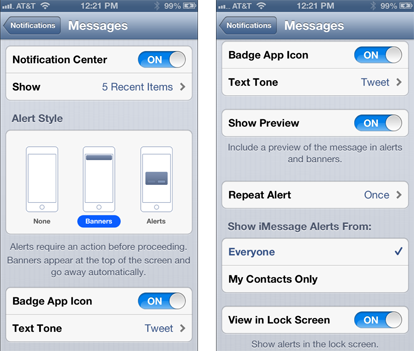
Figure 5-1: You have a myriad of options for new message notifications.
What happens when you receive a new message depends on how you’ve set your notification options, so let’s take a look at them as they appear on the screen, starting at the top:
![]() Notification Center: This option is the master on/off switch for Messages notifications in Notification Center. Turn it on if you want to see ’em there; turn it off if you don’t.
Notification Center: This option is the master on/off switch for Messages notifications in Notification Center. Turn it on if you want to see ’em there; turn it off if you don’t.
 Swipe downward from the top of any screen, except the Lock screen, to see Notification Center. Note, too, that on-screen alerts are not affected by turning this setting on or off. Rather, the Notification Center on/off switch determines whether or not notifications from the Messages app appear in Notification Center. The upshot is that if you choose banners or alerts as the Alert Style, you’ll still see a banner or an alert on the screen when a new message arrives, but you won’t see them in Notification Center.
Swipe downward from the top of any screen, except the Lock screen, to see Notification Center. Note, too, that on-screen alerts are not affected by turning this setting on or off. Rather, the Notification Center on/off switch determines whether or not notifications from the Messages app appear in Notification Center. The upshot is that if you choose banners or alerts as the Alert Style, you’ll still see a banner or an alert on the screen when a new message arrives, but you won’t see them in Notification Center.
![]() Show: Tap to select the number of notifications displayed in Notification Center. The options are 1, 5, or 10 Recent Items.
Show: Tap to select the number of notifications displayed in Notification Center. The options are 1, 5, or 10 Recent Items.
![]() Alert Style: Tap to select the appearance of on-screen notifications. With the Banners option, a banner appears at the top of the screen, as shown in Figure 5-2, and then disappears (with a slick little animation) after a few seconds. The Alerts option requires you to tap a button to proceed, as shown in Figure 5-3. And, of course, the None option means neither a banner nor an alert appears when a new message arrives.
Alert Style: Tap to select the appearance of on-screen notifications. With the Banners option, a banner appears at the top of the screen, as shown in Figure 5-2, and then disappears (with a slick little animation) after a few seconds. The Alerts option requires you to tap a button to proceed, as shown in Figure 5-3. And, of course, the None option means neither a banner nor an alert appears when a new message arrives.

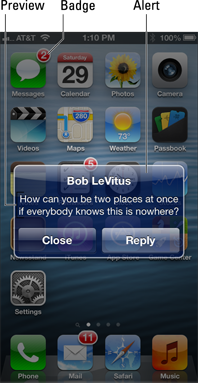
Figure 5-3: Alerts appear midscreen and remain there until you tap Close or Reply.
![]() Badge App Icon: This on/off setting determines whether you see a badge with the number of unread new messages on the Messages icon. (The badge shows 2 in Figure 5-3.)
Badge App Icon: This on/off setting determines whether you see a badge with the number of unread new messages on the Messages icon. (The badge shows 2 in Figure 5-3.)
![]() Text Tone: Tap to change the sound you hear when a new message arrives (or set it to None).
Text Tone: Tap to change the sound you hear when a new message arrives (or set it to None).
![]() Show Preview: This setting determines whether or not you see the first line of the message in banners or alerts.
Show Preview: This setting determines whether or not you see the first line of the message in banners or alerts.
![]() Repeat Alert: Tap to select the number of times an alert is repeated. Your choices are Never, Once, Twice, 3 Times, 5 Times, 10 Times, or at two-minute intervals.
Repeat Alert: Tap to select the number of times an alert is repeated. Your choices are Never, Once, Twice, 3 Times, 5 Times, 10 Times, or at two-minute intervals.
![]() Show iMessage Alerts From: Tap to select either Everyone or My Contacts Only.
Show iMessage Alerts From: Tap to select either Everyone or My Contacts Only.
![]() View in Lock Screen: Enable this option to see new message alerts when your iPhone is locked, as shown in Figure 5-4.
View in Lock Screen: Enable this option to see new message alerts when your iPhone is locked, as shown in Figure 5-4.
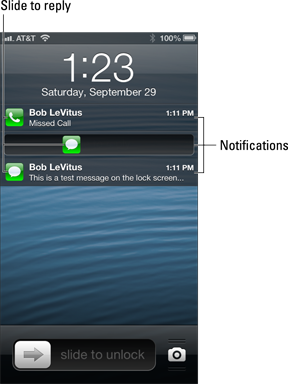
Figure 5-4: When your iPhone is locked, notifications look like this; swipe a notification from left to right to act on it.
Notifications on the Lock screen look like the three that appear in Figure 5-4 regardless of whether you’ve selected banners or alerts. They will remain on the Lock screen until you swipe the Slide to Unlock slider at the bottom of the screen or slide one of the notification icons to reply.
Note that if only one notification is on the Lock screen, the slider at the bottom of the screen says Slide to Reply; if more than one notification is displayed on the Lock screen, you can swipe the icon of a specific notification (as we’re doing with the middle notification in Figure 5-4) to reply to that particular message.
Being a golden receiver: Reading and replying to text messages
Now that you know how to manage your message notifications, here’s the scoop on what happens after you swipe the Slide to Reply slider and have the message on your screen.
To read or reply to the message, tap Reply.
To read or reply to a message after you’ve tapped the Close button, tap the Messages icon. If a message other than the one you’re interested in appears on the screen when you launch the Messages app, tap Messages in the top-left corner of the screen, and then tap the sender’s name; that person’s messages appear on the screen.
To reply to the message on the screen, tap the text-entry field to the left of the Send button, and the keyboard appears. Type your reply and then tap Send. Those of you with an iPhone 4S or 5 can tap the microphone key and speak your reply to Siri, who will translate it into text and type it for you. (To find out more about Siri, your intelligent assistant, see Chapter 7.)
Your SMS conversation is saved as a series of text bubbles. Your messages appear on the right side of the screen in green bubbles; the other person’s messages appear on the left in gray bubbles, as shown in Figure 5-5.
You can delete a conversation in two ways:
![]() If you’re viewing the conversation: Tap the Edit button at the top-right of the conversation screen and a circle appears to the left of each text bubble. Tap a text bubble and a red check mark appears in the circle. When you’ve added a red check mark to all the text bubbles you want to delete, tap the red Delete button at the bottom-left of the screen. Or, to delete the entire conversation in one fell swoop, tap the Clear All button in the top-left corner of the screen.
If you’re viewing the conversation: Tap the Edit button at the top-right of the conversation screen and a circle appears to the left of each text bubble. Tap a text bubble and a red check mark appears in the circle. When you’ve added a red check mark to all the text bubbles you want to delete, tap the red Delete button at the bottom-left of the screen. Or, to delete the entire conversation in one fell swoop, tap the Clear All button in the top-left corner of the screen.
 If you want to forward all or part of a conversation to another mobile phone user (as an SMS, MMS, or iMessage message), follow the same procedure (that is, tap the Edit button, then tap the text bubbles you want to forward so that the red check mark appears in a circle to the left). Now, instead of tapping the red Delete button at the bottom-left of the screen, tap the blue Forward button at the bottom-right of the screen. The contents of the text bubbles with check marks will be copied to a new text message; specify a recipient and then tap Send.
If you want to forward all or part of a conversation to another mobile phone user (as an SMS, MMS, or iMessage message), follow the same procedure (that is, tap the Edit button, then tap the text bubbles you want to forward so that the red check mark appears in a circle to the left). Now, instead of tapping the red Delete button at the bottom-left of the screen, tap the blue Forward button at the bottom-right of the screen. The contents of the text bubbles with check marks will be copied to a new text message; specify a recipient and then tap Send.
![]() If you’re viewing the list of text messages: Tap the Edit button at the top-left of the Messages list, and a red – icon appears to the left of the person’s name. Tap the red – icon and then tap the Delete button that appears to the right of the name to delete the entire conversation with that person.
If you’re viewing the list of text messages: Tap the Edit button at the top-left of the Messages list, and a red – icon appears to the left of the person’s name. Tap the red – icon and then tap the Delete button that appears to the right of the name to delete the entire conversation with that person.
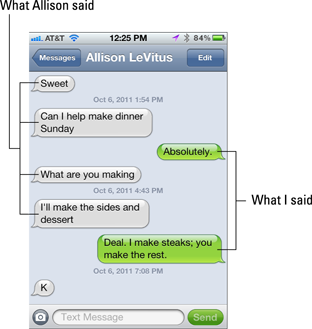
Figure 5-5: This is what an SMS conversation looks like.
MMS: Like SMS with media
To send a picture or video in a message, follow the instructions for sending a text message and then tap the camera icon to the left of the text-entry field at the bottom of the screen. You’ll then have the option of using an existing picture or video or taking a new one. You can also add text to photos or videos. When you’re finished, tap the Send button.
If you receive a picture or video in a message, it appears in a bubble just like text. Tap it to see it full-screen.
 Tap the action icon in the upper-right corner (as shown in the margin) for additional options, which include Email, Twitter, Facebook, Save to Camera Roll, and Print. If you don’t see the action icon, tap the picture or video once and the icon will magically appear.
Tap the action icon in the upper-right corner (as shown in the margin) for additional options, which include Email, Twitter, Facebook, Save to Camera Roll, and Print. If you don’t see the action icon, tap the picture or video once and the icon will magically appear.
Smart messaging tricks
Here are some more things you can do with messages:
![]() To search your messages for a word or phrase, type the word or phrase in the Search field at the very top of the main Messages screen.
To search your messages for a word or phrase, type the word or phrase in the Search field at the very top of the main Messages screen.
![]() To use a Bluetooth keyboard instead of the on-screen keyboard, follow the instructions in Chapter 14 to pair your Bluetooth keyboard with your iPhone.
To use a Bluetooth keyboard instead of the on-screen keyboard, follow the instructions in Chapter 14 to pair your Bluetooth keyboard with your iPhone.
 The Apple Wireless Keyboard ($69) works great with the iPhone (and iPad and iPod touch devices, too).
The Apple Wireless Keyboard ($69) works great with the iPhone (and iPad and iPod touch devices, too).
![]() To send a message to someone in your Favorites or Recents list, tap the Phone icon on the Home screen, and then tap Favorites or Recents, respectively. Tap the blue > icon to the right of a name or number, and then scroll down and tap Text Message at the bottom of the Info screen.
To send a message to someone in your Favorites or Recents list, tap the Phone icon on the Home screen, and then tap Favorites or Recents, respectively. Tap the blue > icon to the right of a name or number, and then scroll down and tap Text Message at the bottom of the Info screen.
![]() To call, e-mail, or start a FaceTime video chat (as discussed in Chapter 4) with someone to whom you’ve sent a message in the past, tap the Messages icon on the Home screen, and then tap the person’s name in the Messages list. Tap the Call or FaceTime button at the top of the conversation to call or start a FaceTime chat (respectively) with the person, or tap the Contacts button and then tap an e-mail address, and a new e-mail message addressed to that person appears. The last part will work only if you have an e-mail address for the contact.
To call, e-mail, or start a FaceTime video chat (as discussed in Chapter 4) with someone to whom you’ve sent a message in the past, tap the Messages icon on the Home screen, and then tap the person’s name in the Messages list. Tap the Call or FaceTime button at the top of the conversation to call or start a FaceTime chat (respectively) with the person, or tap the Contacts button and then tap an e-mail address, and a new e-mail message addressed to that person appears. The last part will work only if you have an e-mail address for the contact.
![]() Did you send someone a message? Receive one from someone? You can add the person to your Contacts list by tapping the person’s name or phone number in the Messages list and then tapping the Add to Contacts button. If the person is already in your Contacts list, the Add to Contacts button doesn’t appear, so don’t bother looking for it.
Did you send someone a message? Receive one from someone? You can add the person to your Contacts list by tapping the person’s name or phone number in the Messages list and then tapping the Add to Contacts button. If the person is already in your Contacts list, the Add to Contacts button doesn’t appear, so don’t bother looking for it.
![]() If a message includes a URL, tap it to open that web page in Safari.
If a message includes a URL, tap it to open that web page in Safari.
![]() If a message includes a phone number, tap it to call that number.
If a message includes a phone number, tap it to call that number.
![]() If a message includes an e-mail address, tap it to open a pre-addressed e-mail message in Mail.
If a message includes an e-mail address, tap it to open a pre-addressed e-mail message in Mail.
![]() If a message includes a street address, tap it to see a map in Maps.
If a message includes a street address, tap it to see a map in Maps.
And that’s all there is to it. You are now an official messaging maven.
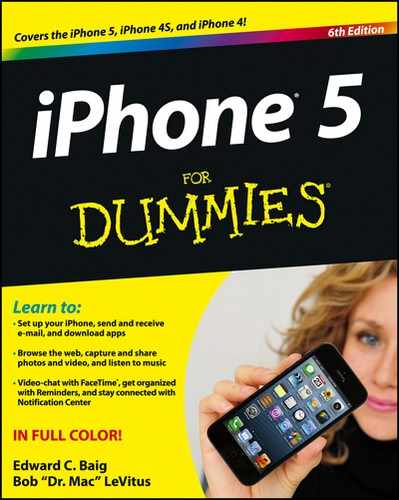
 SMS is the acronym for the Short Message Service protocol; MMS is the acronym for the Multimedia Messaging Service protocol. Most phones sold today support one or both protocols. MMS support has been built into iOS since version 3 and is available on the iPhone 3G and later.
SMS is the acronym for the Short Message Service protocol; MMS is the acronym for the Multimedia Messaging Service protocol. Most phones sold today support one or both protocols. MMS support has been built into iOS since version 3 and is available on the iPhone 3G and later.